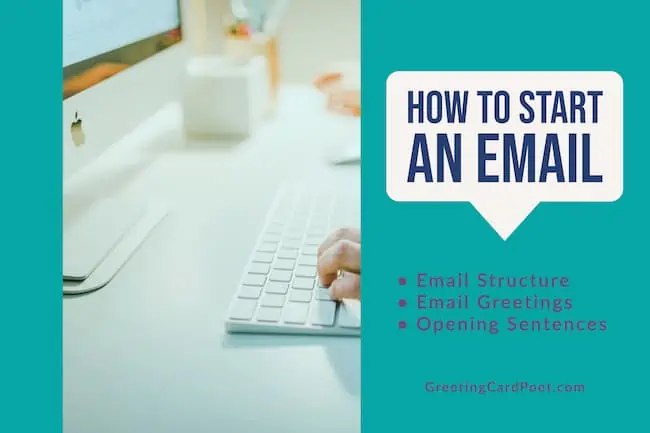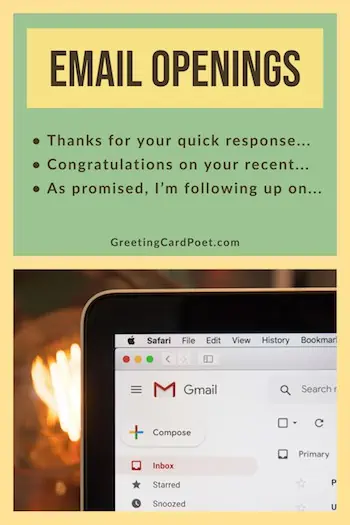How to Start an Email
Does it really make a difference in how you start an email? Email has virtually replaced all traditional mail as the preferred form of communication.
Yes, it does matter how you begin your electronic correspondence. Archaic openings like Dear Sir/Madam or To Whom it may concern are passé. Even worse is a misspelled or incorrect name.
Advice For How to Start an Email
Using the correct salutation is essential, whether the email is going to a person or a company. Here are some ways to start an email:
If the email is going to an acquaintance or friend, it is perfectly acceptable to use Hi. Follow Hi with the recipient’s name and a comma. If you want the email to be a little less casual, you can use Hello instead of Hi.
Dear is always a good choice in any situation. Some consider it a little stiff, but it is used so commonly that everyone accepts it. If it is a friend, relative, or colleague using Dear followed by their name, like Dear Todd, it is perfectly acceptable.
If you don’t know the person that well, you can substitute the first name with a title, Dear Mr. Peterson; if the one you are writing to is in the military or government, you should use their rank or position, such as Dear Lieutenant Peterson. And, if you do not know the gender of the person, you are sending the email to start the email with Dear Terry Peterson.
Other openings that are perfectly acceptable for familiar emails include Greetings. Hi there, and Hello there.

Email Structure
Not unlike a formal or informal traditional letter, there is a standard structure to follow for an email. The contents of your email can be divided into two parts: header and body.
The header contains the whom the email is being sent to and the date and time. It also explains who the email is from and what subject is to be covered in the email. The header will also indicate if there are any attachments.
Under the email start, as listed above, is the body of the email. The body contains the message you want to be delivered in the email. This is where you would insert your personal information to a friend or professional information to a company.
You might like How to Write and Introductory Paragraph
How to Start an Email to a Company
An email to a company should be brief, precise, and to the point. To start the email, you should greet your contact at the company like Dear Mr. Sullivan. Then, give a short biography of yourself. Explain why you are sending this email and the results you would like to get. Include your email signature and additional contact information, like a phone number.
Make sure the message is well-written and free of spelling or grammar mistakes. Consider using an app like Grammarly. Grammarly is an app that was developed as a digital writing tool for individuals and businesses. You can get a free version from the app store or purchase a premium version if you do a lot of writing.
How to Start an Email to a Teacher
If you’re looking to write an email to a teacher or professor, please read this.
Never use email as a substitute for a face-to-face meeting. However, if you feel the message needs to be covered in-depth and have written support, then an email is appropriate. Your email account should have a formal name, not a nickname. The subject line should clearly spell out what the email is about.
The email should be formal, so using your teacher’s last name is correct. Start the email like Dear Mrs. Simpson. If your teacher is a professor, use Dear Professor Simpson. Below the greeting, create a statement that gives the purpose for your email. Refer to a particular assignment or reading material and give specifics. If you are having a problem, try and suggest a solution.
Proofread the email carefully and check your tone, spelling, and grammar. An app like Grammarly can be beneficial in this regard. Sign the email with your full name and include any contact information your teacher may not have, like a cell phone number. Allow at least 24 hours to get a replay and check your email frequently.
Check out Tips on Paragraph Length.
How to Start an Email to a Group
A group of people you are familiar with calls for a more informal greeting. You can use Hello guys, Hello guys and gals, Hey gang, or Hi everyone. If the email is going to a group that you work with, Dear Colleagues is appropriate. An email to a company should contain each recipient’s name—for example, Dear Mr. Johnson, Ms. Kluny, and Mr. Finley.
The rest of the email should follow the standard email structure.
Writing a business or professional email video
Good Email Opening Sentences
The first sentence of the email is important. It sets the tone of the email and can inform the reader of the information that follows. Here are some sample email opening sentences:
1.) I enjoyed meeting you yesterday.
2.) Thank you for your interest in our company.
3.) I just wanted to send you a brief note about
4.) I hope you had a lovely weekend.
5.) As we discussed at our meeting, I
6.) How is everything going?
7.) Thanks for your help
8.) I have a quick question.
9.) Are you familiar with
10.) Thanks again for the update.
11.) Just checking in to see if
12.) I have a quick question.
13.) As promised, I’m following up on
14.) Thanks for the quick response.
15.) It was great talking to you last week.
16.) Can you provide me with an update on
17.) It was great to see you recently.
18.) I hope you are doing well.
19.) Congratulations on your recent
20.) Thank you for your help.
Best Professional Email Opening Sentence
If I had to recommend just one opening sentence for an email, go with this one, “I hope this email finds you well.” It’s kind of the “How are you?” of greetings. It works on nearly all occasions. It’s pleasant. Not many folks would find this objectionable in any way.
Another similar opening that is very useful is, “Hope all is well.” Or, try, “I hope you are doing well.”

Good Email Greetings and Salutations
Sometimes you just don’t want to be traditional; you want to start your email with something more unique. Here are some creative email greetings:
21.) Good Morning Sunshine
22.) I hope you’re awake.
23.) I have good news and bad news,
24.) Happy Monday!
25.) Please allow me to introduce myself.
26.) Congratulations, I sent you an email.
27.) This is not spam.
28.) How’s the view?
29.) It’s almost Friday.
30.) It’s going to be okay.
31.) Hello Sunshine,
32.) It’s the first day of the rest of the week.
33.) I hope all is well.
34.) It’s me again.
35.) Hate to be a pest, but here I go.
How to Send a Reminder Email
A follow-up reminder email should be courteous but to the point. Being respectful and not too formal is critical to get a response. It can be appropriate to forward the original email as a reminder. The initial email spells out why you made contact and what your request was. The original email can be accompanied by an establishing statement. These include “Have you had time to look at this,” “Just looking for a response to…,” or “Here’s my email again.”
You should wait at least five business days before sending an email reminder. Thank the recipient for their time. Also, a gentle reminder to the recipient to follow up is a good thing. And, you should have a nice closing like Kind regards, Sincerely, or Best Wishes.
Email is the new go-to for personal and business communications. This means that you should have some guidelines when using email. A properly written email can be just as effective as traditional mail. Besides, you’re saving trees.
You might like the How to Start a Letter page.
10 Useful Email Tips and Tricks
- If you’re looking for a response to your email by phone, include your phone number right after your name sign-off.
- Also, if a response is needed, make a point to include the action item in the last paragraph of the email so folks don’t forget as they read the rest of the email’s contents.
- Your subject line is critical. Spend an extra minute at least on crafting the perfect subject headline.
- Make your subject line descriptive — this will increase the likelihood of the email being read.
- Avoid attachments if you can.
- Spellcheck and proofread. Ideally, have someone else proofread your email first if it’s important.
- Choose a readable font appropriate to the occasion. An informal font with a formal subject matter creates a disconnect.
- Here’s a good rule of thumb. If the message is a positive one, put it in writing. If the message is negative, consider whether a phone call or a meeting in person would be more appropriate. The written word has a longer shelf life.
- Be responsive when someone sends you an email. A prompt response, even if it’s just, “I plan on reading this soon and getting back to you,” is better than letting it wait indefinitely.
- Know your audience. Make sure you understand who your email is going to if you’re replying to an email. Are you hitting, “Reply All,” or just “Reply to Sender”? If the initial audience is a big one, think twice before hitting “Reply All”.
You might like How to Write a Conclusion Paragraph.
Email Fun Facts
- Some 2.7 million emails are sent per second. That’s over 200 billion emails sent per day. Wow, there’s a lot of clutter out there. Make sure your emails are meaningful.
- The chance of an email being opened is one percent if it hasn’t been opened in the first 24 hours. Choose the timing of when you send your emails out; e.g., late Friday afternoon might not be the best time.
- About one in four people check their emails before they get out of bed in the morning. There has to be a better way to start the day!
- Over 85% of professionals prefer to communicate by email. It’s their favorite medium.
- Mondays, Tuesdays, and Wednesdays are the days of the week with the most email opens.
- Over 66% of emails in the United States are opened on mobile devices. This suggests that shorter emails might be better than longer ones.
- The first email system was developed in 1971.
So, there you have it on emails. I hope you enjoyed it.
By Tim Moodie with Mike O’Halloran
Tim Moodie has been a Freelance Writer for over 30 years. He spent many years writing funny greeting cards, printing and broadcasting commercials, and articles, and of course, writing emails. Mike is the editor of Greeting Card Poet.
Encore
You’re on the How to Start an Email page.
You might like:
